An Essay on the Role, Power, and Responsibility of Media in Healthcare
VerifiedAdded on 2020/05/11
|13
|2928
|37
Essay
AI Summary
This essay critically analyzes the role, power, and responsibility of media in the healthcare sector of Australia. It explores the reach of various media platforms, including mass media, social media, and print media, and their influence on the diverse population. The essay discusses both the positive aspects, such as promoting governmental healthcare strategies and spreading awareness about diseases, and the negative aspects, such as media bias and the spread of misinformation, particularly in a culturally sensitive context. It provides examples of how media has influenced the healthcare sector, both positively and negatively, and examines the impact of media on culturally safe healthcare. The essay also delves into the influence of television and print media, highlighting their effects on healthcare accessibility, public awareness, and the potential for both positive and negative portrayals of healthcare policies. The conclusion emphasizes the importance of media's role in disseminating healthcare information while cautioning against the negative consequences of biased reporting and the need for media to prioritize cultural safety and ethical practices in healthcare communication.
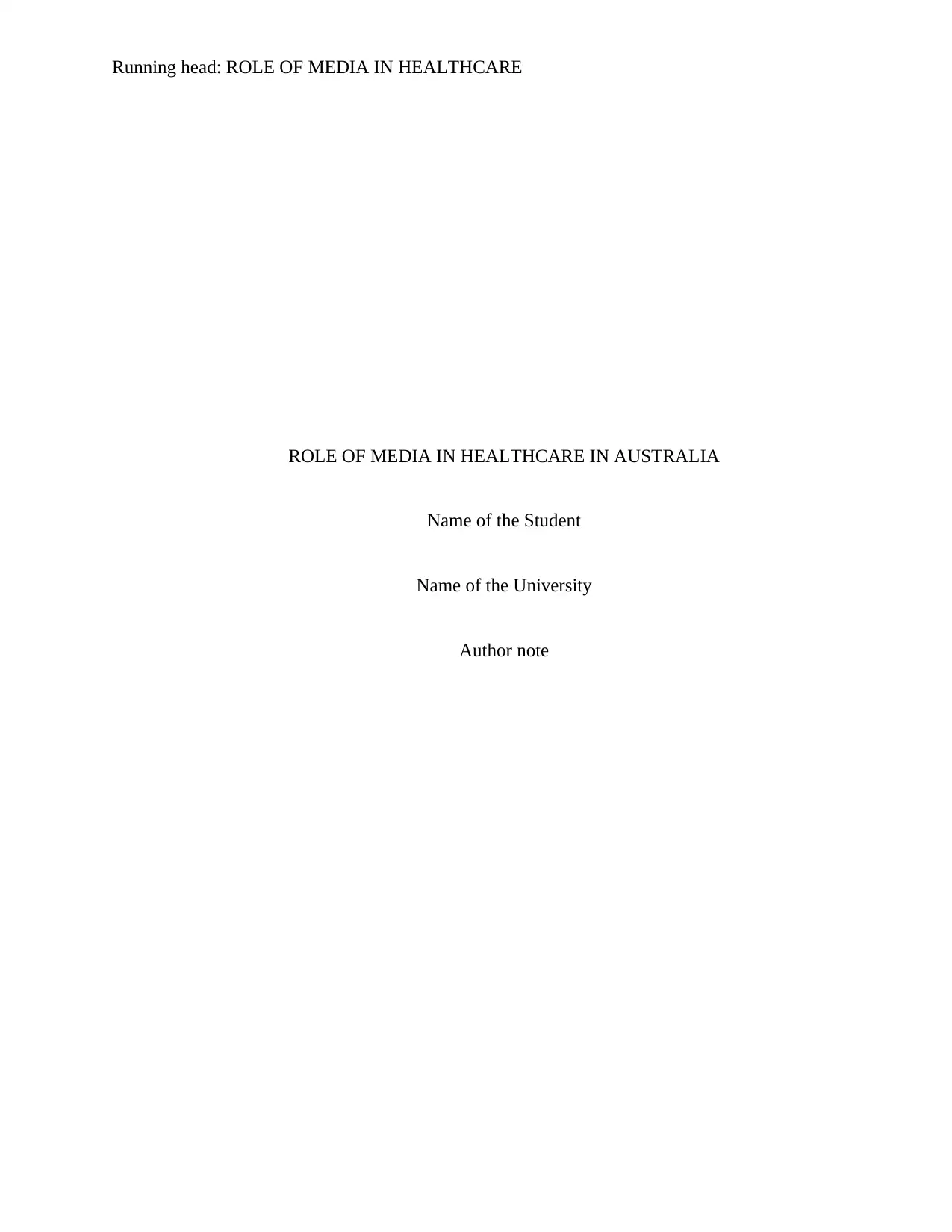
Running head: ROLE OF MEDIA IN HEALTHCARE
ROLE OF MEDIA IN HEALTHCARE IN AUSTRALIA
Name of the Student
Name of the University
Author note
ROLE OF MEDIA IN HEALTHCARE IN AUSTRALIA
Name of the Student
Name of the University
Author note
Paraphrase This Document
Need a fresh take? Get an instant paraphrase of this document with our AI Paraphraser
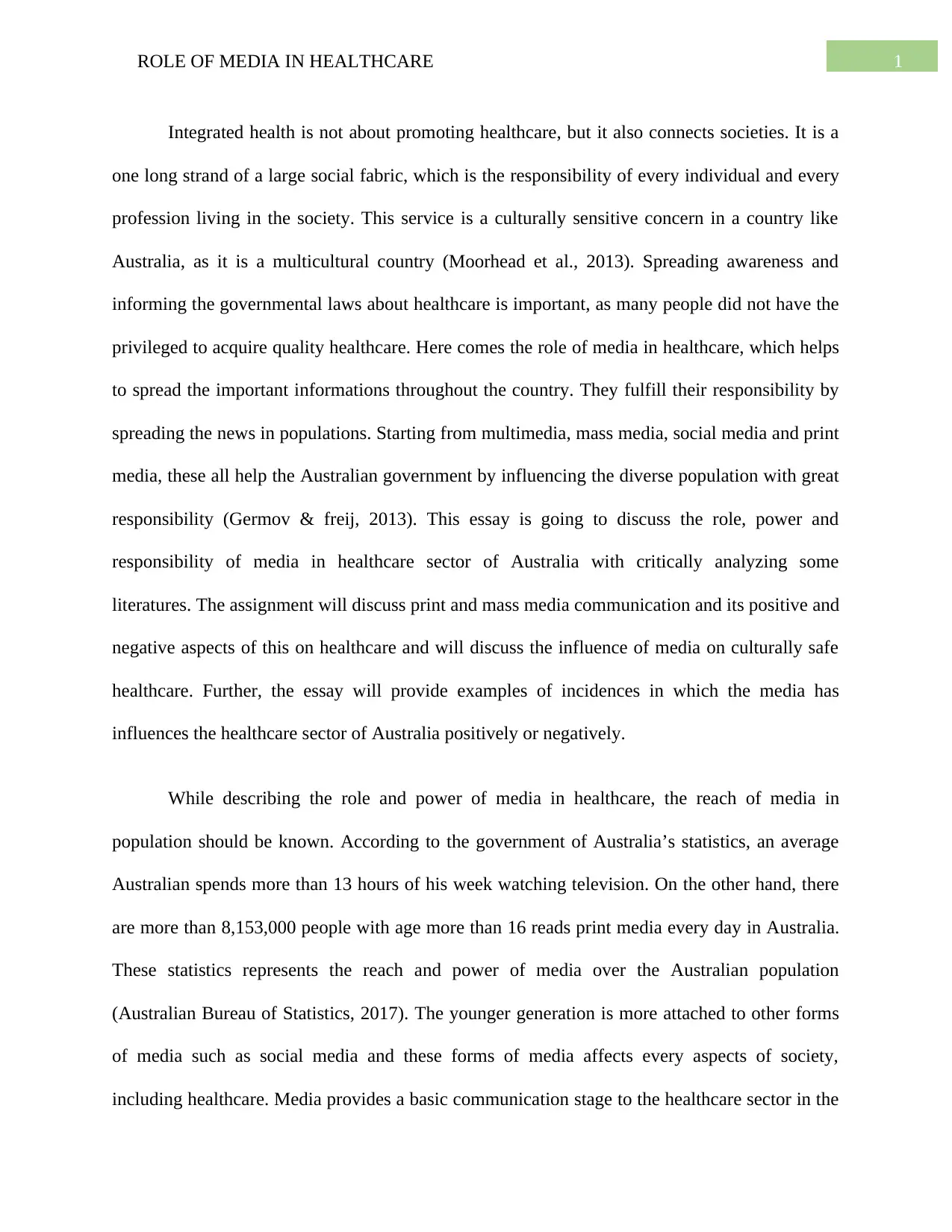
1ROLE OF MEDIA IN HEALTHCARE
Integrated health is not about promoting healthcare, but it also connects societies. It is a
one long strand of a large social fabric, which is the responsibility of every individual and every
profession living in the society. This service is a culturally sensitive concern in a country like
Australia, as it is a multicultural country (Moorhead et al., 2013). Spreading awareness and
informing the governmental laws about healthcare is important, as many people did not have the
privileged to acquire quality healthcare. Here comes the role of media in healthcare, which helps
to spread the important informations throughout the country. They fulfill their responsibility by
spreading the news in populations. Starting from multimedia, mass media, social media and print
media, these all help the Australian government by influencing the diverse population with great
responsibility (Germov & freij, 2013). This essay is going to discuss the role, power and
responsibility of media in healthcare sector of Australia with critically analyzing some
literatures. The assignment will discuss print and mass media communication and its positive and
negative aspects of this on healthcare and will discuss the influence of media on culturally safe
healthcare. Further, the essay will provide examples of incidences in which the media has
influences the healthcare sector of Australia positively or negatively.
While describing the role and power of media in healthcare, the reach of media in
population should be known. According to the government of Australia’s statistics, an average
Australian spends more than 13 hours of his week watching television. On the other hand, there
are more than 8,153,000 people with age more than 16 reads print media every day in Australia.
These statistics represents the reach and power of media over the Australian population
(Australian Bureau of Statistics, 2017). The younger generation is more attached to other forms
of media such as social media and these forms of media affects every aspects of society,
including healthcare. Media provides a basic communication stage to the healthcare sector in the
Integrated health is not about promoting healthcare, but it also connects societies. It is a
one long strand of a large social fabric, which is the responsibility of every individual and every
profession living in the society. This service is a culturally sensitive concern in a country like
Australia, as it is a multicultural country (Moorhead et al., 2013). Spreading awareness and
informing the governmental laws about healthcare is important, as many people did not have the
privileged to acquire quality healthcare. Here comes the role of media in healthcare, which helps
to spread the important informations throughout the country. They fulfill their responsibility by
spreading the news in populations. Starting from multimedia, mass media, social media and print
media, these all help the Australian government by influencing the diverse population with great
responsibility (Germov & freij, 2013). This essay is going to discuss the role, power and
responsibility of media in healthcare sector of Australia with critically analyzing some
literatures. The assignment will discuss print and mass media communication and its positive and
negative aspects of this on healthcare and will discuss the influence of media on culturally safe
healthcare. Further, the essay will provide examples of incidences in which the media has
influences the healthcare sector of Australia positively or negatively.
While describing the role and power of media in healthcare, the reach of media in
population should be known. According to the government of Australia’s statistics, an average
Australian spends more than 13 hours of his week watching television. On the other hand, there
are more than 8,153,000 people with age more than 16 reads print media every day in Australia.
These statistics represents the reach and power of media over the Australian population
(Australian Bureau of Statistics, 2017). The younger generation is more attached to other forms
of media such as social media and these forms of media affects every aspects of society,
including healthcare. Media provides a basic communication stage to the healthcare sector in the
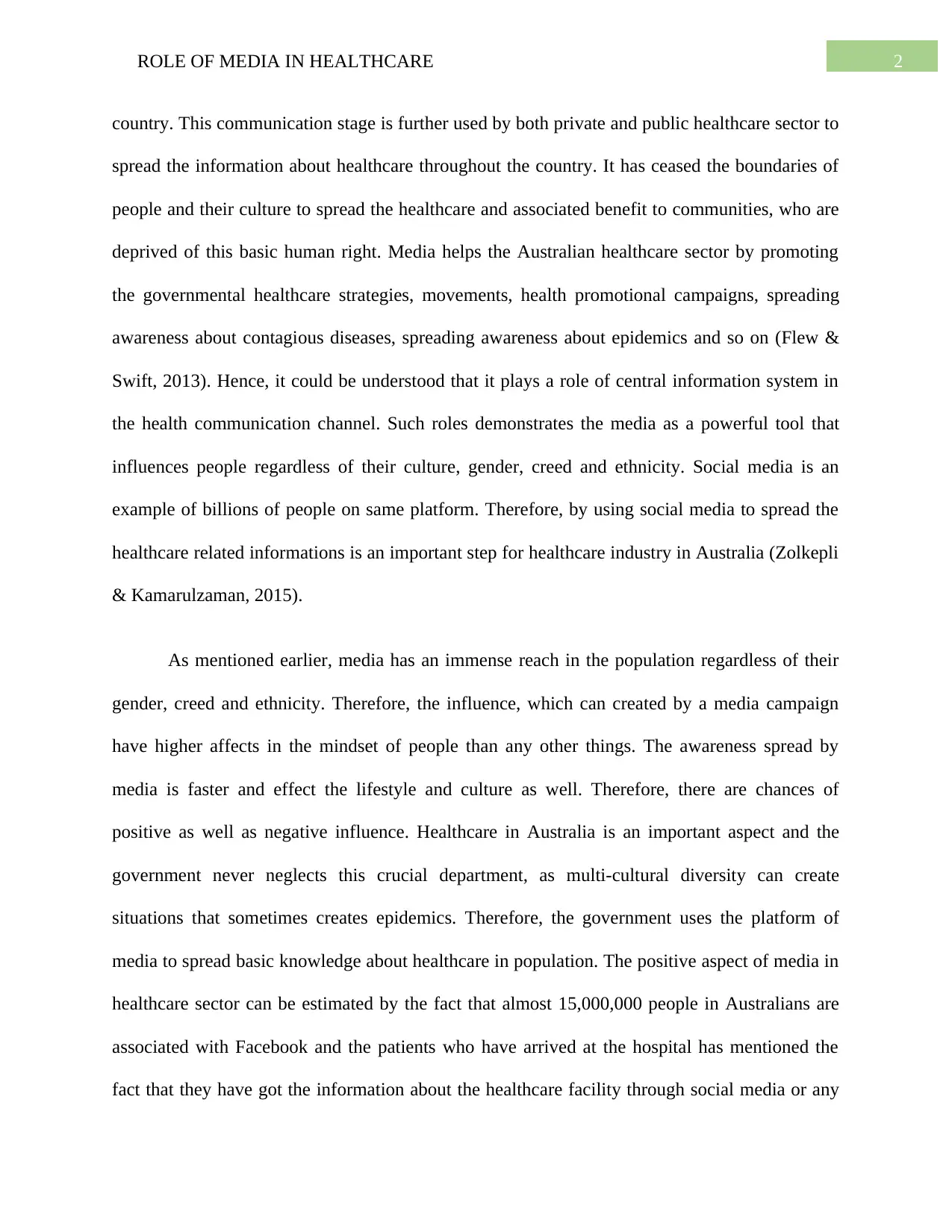
2ROLE OF MEDIA IN HEALTHCARE
country. This communication stage is further used by both private and public healthcare sector to
spread the information about healthcare throughout the country. It has ceased the boundaries of
people and their culture to spread the healthcare and associated benefit to communities, who are
deprived of this basic human right. Media helps the Australian healthcare sector by promoting
the governmental healthcare strategies, movements, health promotional campaigns, spreading
awareness about contagious diseases, spreading awareness about epidemics and so on (Flew &
Swift, 2013). Hence, it could be understood that it plays a role of central information system in
the health communication channel. Such roles demonstrates the media as a powerful tool that
influences people regardless of their culture, gender, creed and ethnicity. Social media is an
example of billions of people on same platform. Therefore, by using social media to spread the
healthcare related informations is an important step for healthcare industry in Australia (Zolkepli
& Kamarulzaman, 2015).
As mentioned earlier, media has an immense reach in the population regardless of their
gender, creed and ethnicity. Therefore, the influence, which can created by a media campaign
have higher affects in the mindset of people than any other things. The awareness spread by
media is faster and effect the lifestyle and culture as well. Therefore, there are chances of
positive as well as negative influence. Healthcare in Australia is an important aspect and the
government never neglects this crucial department, as multi-cultural diversity can create
situations that sometimes creates epidemics. Therefore, the government uses the platform of
media to spread basic knowledge about healthcare in population. The positive aspect of media in
healthcare sector can be estimated by the fact that almost 15,000,000 people in Australians are
associated with Facebook and the patients who have arrived at the hospital has mentioned the
fact that they have got the information about the healthcare facility through social media or any
country. This communication stage is further used by both private and public healthcare sector to
spread the information about healthcare throughout the country. It has ceased the boundaries of
people and their culture to spread the healthcare and associated benefit to communities, who are
deprived of this basic human right. Media helps the Australian healthcare sector by promoting
the governmental healthcare strategies, movements, health promotional campaigns, spreading
awareness about contagious diseases, spreading awareness about epidemics and so on (Flew &
Swift, 2013). Hence, it could be understood that it plays a role of central information system in
the health communication channel. Such roles demonstrates the media as a powerful tool that
influences people regardless of their culture, gender, creed and ethnicity. Social media is an
example of billions of people on same platform. Therefore, by using social media to spread the
healthcare related informations is an important step for healthcare industry in Australia (Zolkepli
& Kamarulzaman, 2015).
As mentioned earlier, media has an immense reach in the population regardless of their
gender, creed and ethnicity. Therefore, the influence, which can created by a media campaign
have higher affects in the mindset of people than any other things. The awareness spread by
media is faster and effect the lifestyle and culture as well. Therefore, there are chances of
positive as well as negative influence. Healthcare in Australia is an important aspect and the
government never neglects this crucial department, as multi-cultural diversity can create
situations that sometimes creates epidemics. Therefore, the government uses the platform of
media to spread basic knowledge about healthcare in population. The positive aspect of media in
healthcare sector can be estimated by the fact that almost 15,000,000 people in Australians are
associated with Facebook and the patients who have arrived at the hospital has mentioned the
fact that they have got the information about the healthcare facility through social media or any
⊘ This is a preview!⊘
Do you want full access?
Subscribe today to unlock all pages.

Trusted by 1+ million students worldwide
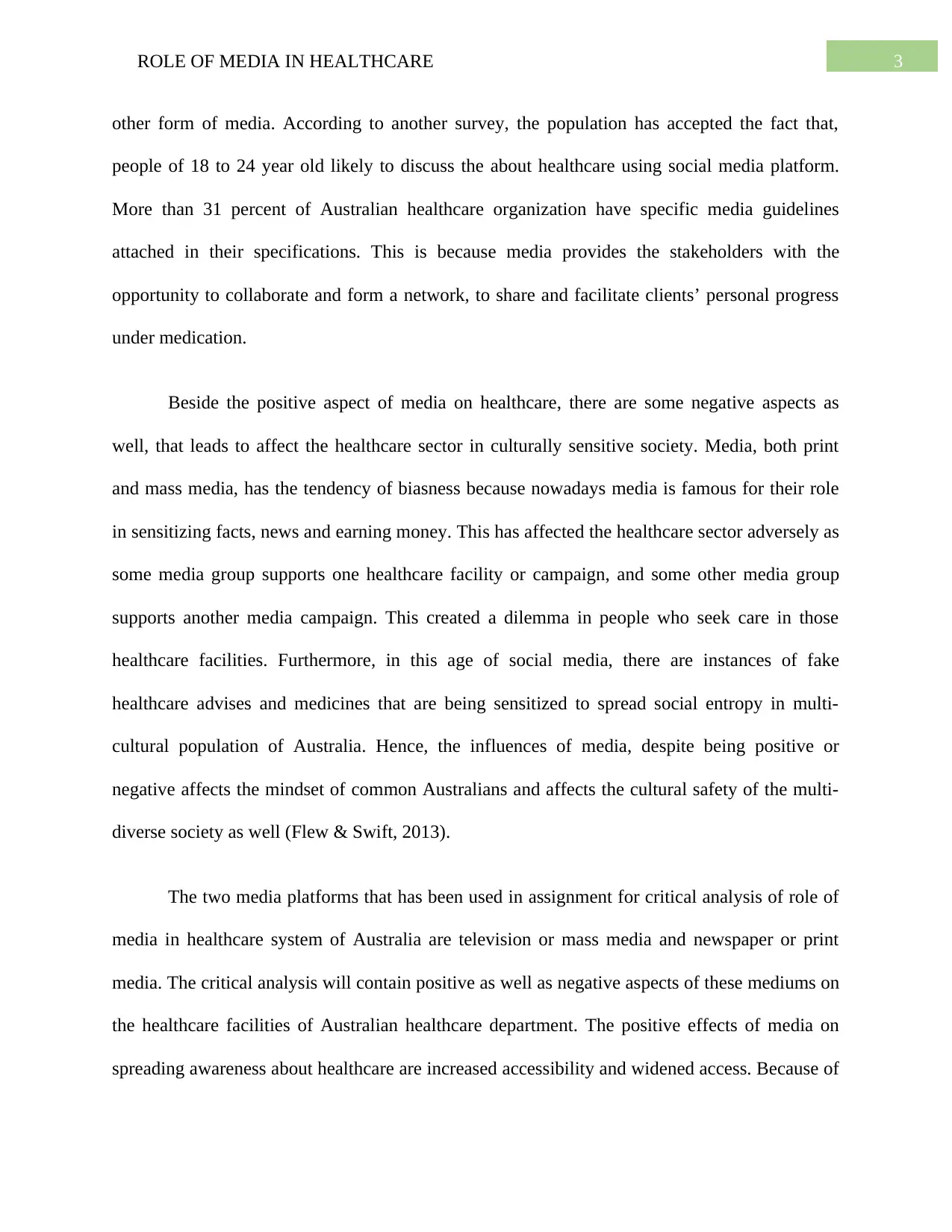
3ROLE OF MEDIA IN HEALTHCARE
other form of media. According to another survey, the population has accepted the fact that,
people of 18 to 24 year old likely to discuss the about healthcare using social media platform.
More than 31 percent of Australian healthcare organization have specific media guidelines
attached in their specifications. This is because media provides the stakeholders with the
opportunity to collaborate and form a network, to share and facilitate clients’ personal progress
under medication.
Beside the positive aspect of media on healthcare, there are some negative aspects as
well, that leads to affect the healthcare sector in culturally sensitive society. Media, both print
and mass media, has the tendency of biasness because nowadays media is famous for their role
in sensitizing facts, news and earning money. This has affected the healthcare sector adversely as
some media group supports one healthcare facility or campaign, and some other media group
supports another media campaign. This created a dilemma in people who seek care in those
healthcare facilities. Furthermore, in this age of social media, there are instances of fake
healthcare advises and medicines that are being sensitized to spread social entropy in multi-
cultural population of Australia. Hence, the influences of media, despite being positive or
negative affects the mindset of common Australians and affects the cultural safety of the multi-
diverse society as well (Flew & Swift, 2013).
The two media platforms that has been used in assignment for critical analysis of role of
media in healthcare system of Australia are television or mass media and newspaper or print
media. The critical analysis will contain positive as well as negative aspects of these mediums on
the healthcare facilities of Australian healthcare department. The positive effects of media on
spreading awareness about healthcare are increased accessibility and widened access. Because of
other form of media. According to another survey, the population has accepted the fact that,
people of 18 to 24 year old likely to discuss the about healthcare using social media platform.
More than 31 percent of Australian healthcare organization have specific media guidelines
attached in their specifications. This is because media provides the stakeholders with the
opportunity to collaborate and form a network, to share and facilitate clients’ personal progress
under medication.
Beside the positive aspect of media on healthcare, there are some negative aspects as
well, that leads to affect the healthcare sector in culturally sensitive society. Media, both print
and mass media, has the tendency of biasness because nowadays media is famous for their role
in sensitizing facts, news and earning money. This has affected the healthcare sector adversely as
some media group supports one healthcare facility or campaign, and some other media group
supports another media campaign. This created a dilemma in people who seek care in those
healthcare facilities. Furthermore, in this age of social media, there are instances of fake
healthcare advises and medicines that are being sensitized to spread social entropy in multi-
cultural population of Australia. Hence, the influences of media, despite being positive or
negative affects the mindset of common Australians and affects the cultural safety of the multi-
diverse society as well (Flew & Swift, 2013).
The two media platforms that has been used in assignment for critical analysis of role of
media in healthcare system of Australia are television or mass media and newspaper or print
media. The critical analysis will contain positive as well as negative aspects of these mediums on
the healthcare facilities of Australian healthcare department. The positive effects of media on
spreading awareness about healthcare are increased accessibility and widened access. Because of
Paraphrase This Document
Need a fresh take? Get an instant paraphrase of this document with our AI Paraphraser
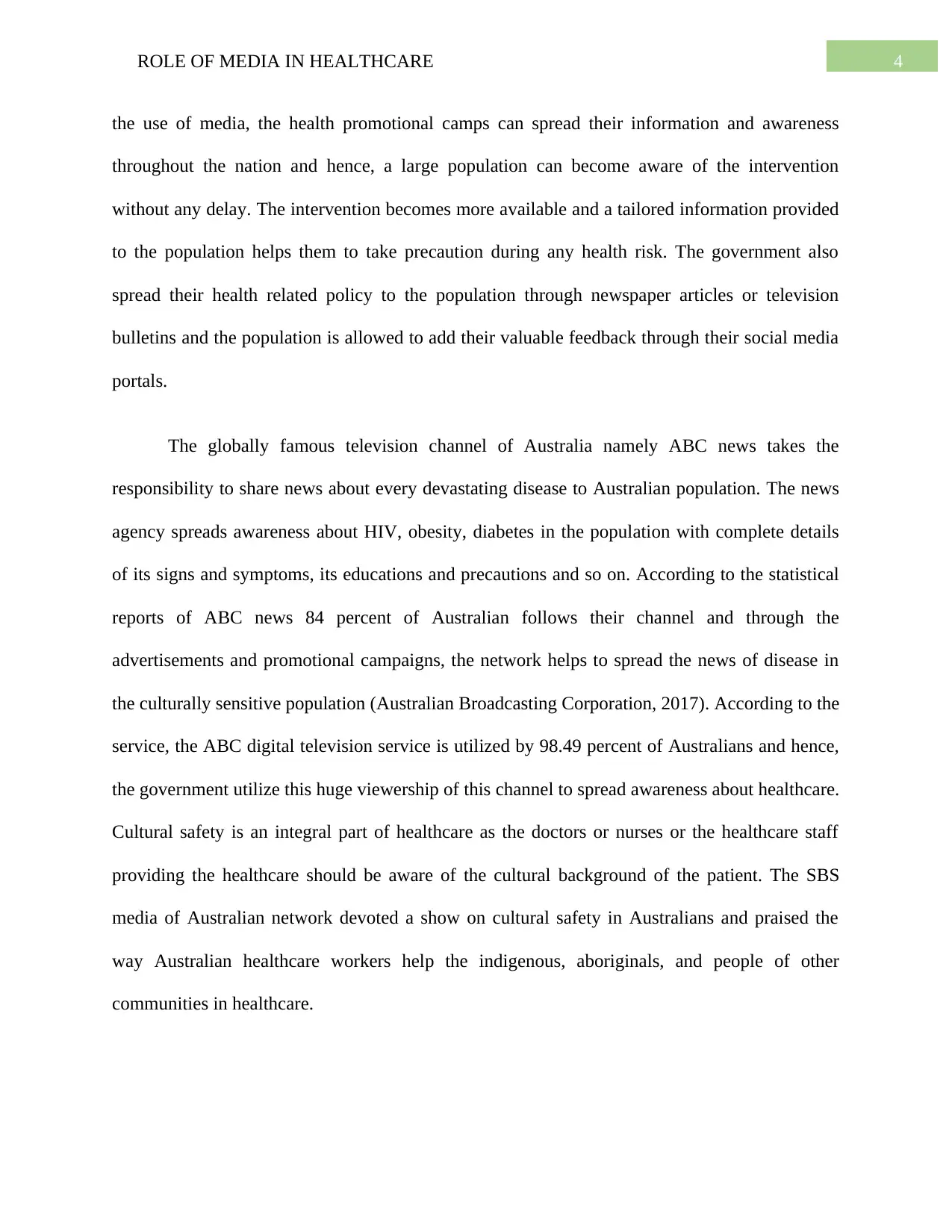
4ROLE OF MEDIA IN HEALTHCARE
the use of media, the health promotional camps can spread their information and awareness
throughout the nation and hence, a large population can become aware of the intervention
without any delay. The intervention becomes more available and a tailored information provided
to the population helps them to take precaution during any health risk. The government also
spread their health related policy to the population through newspaper articles or television
bulletins and the population is allowed to add their valuable feedback through their social media
portals.
The globally famous television channel of Australia namely ABC news takes the
responsibility to share news about every devastating disease to Australian population. The news
agency spreads awareness about HIV, obesity, diabetes in the population with complete details
of its signs and symptoms, its educations and precautions and so on. According to the statistical
reports of ABC news 84 percent of Australian follows their channel and through the
advertisements and promotional campaigns, the network helps to spread the news of disease in
the culturally sensitive population (Australian Broadcasting Corporation, 2017). According to the
service, the ABC digital television service is utilized by 98.49 percent of Australians and hence,
the government utilize this huge viewership of this channel to spread awareness about healthcare.
Cultural safety is an integral part of healthcare as the doctors or nurses or the healthcare staff
providing the healthcare should be aware of the cultural background of the patient. The SBS
media of Australian network devoted a show on cultural safety in Australians and praised the
way Australian healthcare workers help the indigenous, aboriginals, and people of other
communities in healthcare.
the use of media, the health promotional camps can spread their information and awareness
throughout the nation and hence, a large population can become aware of the intervention
without any delay. The intervention becomes more available and a tailored information provided
to the population helps them to take precaution during any health risk. The government also
spread their health related policy to the population through newspaper articles or television
bulletins and the population is allowed to add their valuable feedback through their social media
portals.
The globally famous television channel of Australia namely ABC news takes the
responsibility to share news about every devastating disease to Australian population. The news
agency spreads awareness about HIV, obesity, diabetes in the population with complete details
of its signs and symptoms, its educations and precautions and so on. According to the statistical
reports of ABC news 84 percent of Australian follows their channel and through the
advertisements and promotional campaigns, the network helps to spread the news of disease in
the culturally sensitive population (Australian Broadcasting Corporation, 2017). According to the
service, the ABC digital television service is utilized by 98.49 percent of Australians and hence,
the government utilize this huge viewership of this channel to spread awareness about healthcare.
Cultural safety is an integral part of healthcare as the doctors or nurses or the healthcare staff
providing the healthcare should be aware of the cultural background of the patient. The SBS
media of Australian network devoted a show on cultural safety in Australians and praised the
way Australian healthcare workers help the indigenous, aboriginals, and people of other
communities in healthcare.
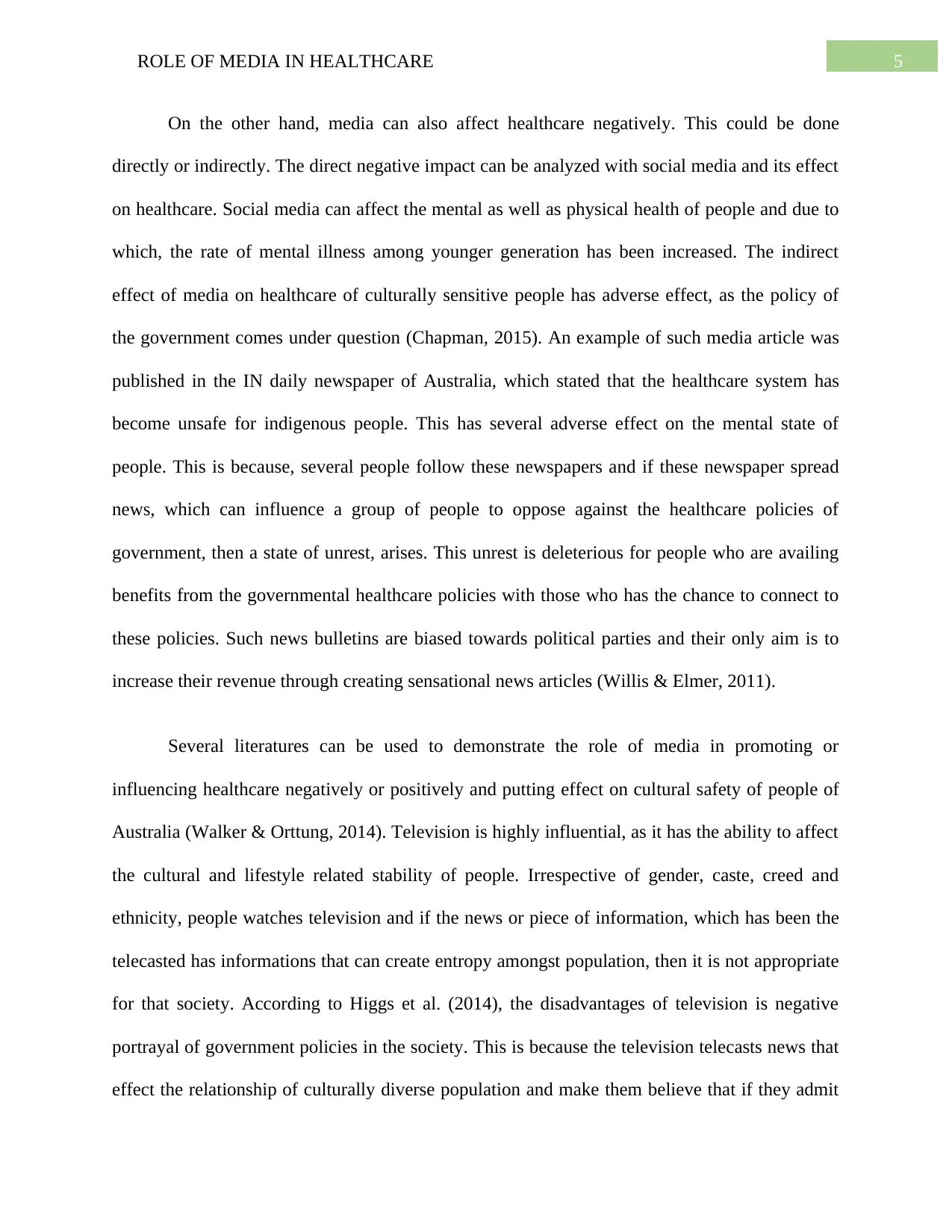
5ROLE OF MEDIA IN HEALTHCARE
On the other hand, media can also affect healthcare negatively. This could be done
directly or indirectly. The direct negative impact can be analyzed with social media and its effect
on healthcare. Social media can affect the mental as well as physical health of people and due to
which, the rate of mental illness among younger generation has been increased. The indirect
effect of media on healthcare of culturally sensitive people has adverse effect, as the policy of
the government comes under question (Chapman, 2015). An example of such media article was
published in the IN daily newspaper of Australia, which stated that the healthcare system has
become unsafe for indigenous people. This has several adverse effect on the mental state of
people. This is because, several people follow these newspapers and if these newspaper spread
news, which can influence a group of people to oppose against the healthcare policies of
government, then a state of unrest, arises. This unrest is deleterious for people who are availing
benefits from the governmental healthcare policies with those who has the chance to connect to
these policies. Such news bulletins are biased towards political parties and their only aim is to
increase their revenue through creating sensational news articles (Willis & Elmer, 2011).
Several literatures can be used to demonstrate the role of media in promoting or
influencing healthcare negatively or positively and putting effect on cultural safety of people of
Australia (Walker & Orttung, 2014). Television is highly influential, as it has the ability to affect
the cultural and lifestyle related stability of people. Irrespective of gender, caste, creed and
ethnicity, people watches television and if the news or piece of information, which has been the
telecasted has informations that can create entropy amongst population, then it is not appropriate
for that society. According to Higgs et al. (2014), the disadvantages of television is negative
portrayal of government policies in the society. This is because the television telecasts news that
effect the relationship of culturally diverse population and make them believe that if they admit
On the other hand, media can also affect healthcare negatively. This could be done
directly or indirectly. The direct negative impact can be analyzed with social media and its effect
on healthcare. Social media can affect the mental as well as physical health of people and due to
which, the rate of mental illness among younger generation has been increased. The indirect
effect of media on healthcare of culturally sensitive people has adverse effect, as the policy of
the government comes under question (Chapman, 2015). An example of such media article was
published in the IN daily newspaper of Australia, which stated that the healthcare system has
become unsafe for indigenous people. This has several adverse effect on the mental state of
people. This is because, several people follow these newspapers and if these newspaper spread
news, which can influence a group of people to oppose against the healthcare policies of
government, then a state of unrest, arises. This unrest is deleterious for people who are availing
benefits from the governmental healthcare policies with those who has the chance to connect to
these policies. Such news bulletins are biased towards political parties and their only aim is to
increase their revenue through creating sensational news articles (Willis & Elmer, 2011).
Several literatures can be used to demonstrate the role of media in promoting or
influencing healthcare negatively or positively and putting effect on cultural safety of people of
Australia (Walker & Orttung, 2014). Television is highly influential, as it has the ability to affect
the cultural and lifestyle related stability of people. Irrespective of gender, caste, creed and
ethnicity, people watches television and if the news or piece of information, which has been the
telecasted has informations that can create entropy amongst population, then it is not appropriate
for that society. According to Higgs et al. (2014), the disadvantages of television is negative
portrayal of government policies in the society. This is because the television telecasts news that
effect the relationship of culturally diverse population and make them believe that if they admit
⊘ This is a preview!⊘
Do you want full access?
Subscribe today to unlock all pages.

Trusted by 1+ million students worldwide
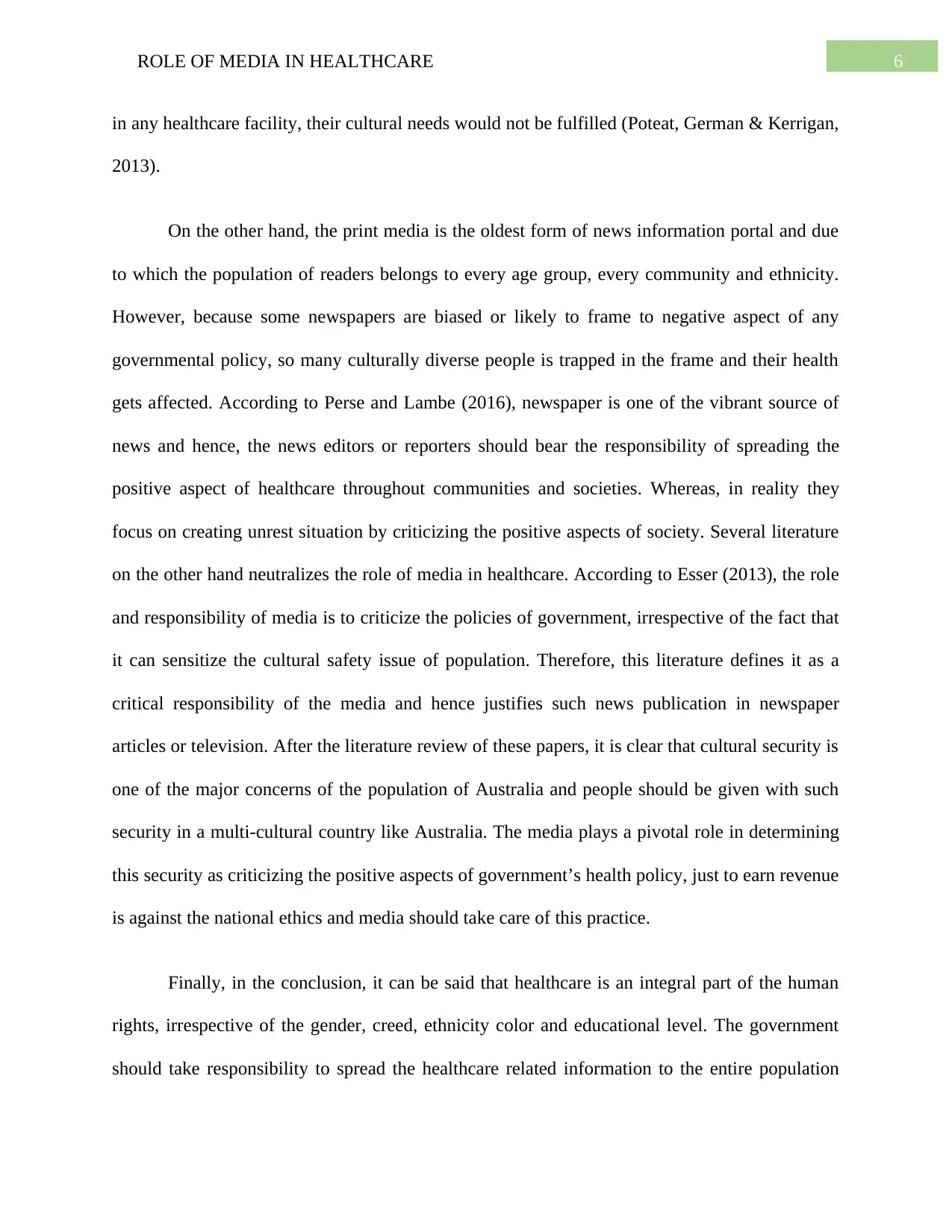
6ROLE OF MEDIA IN HEALTHCARE
in any healthcare facility, their cultural needs would not be fulfilled (Poteat, German & Kerrigan,
2013).
On the other hand, the print media is the oldest form of news information portal and due
to which the population of readers belongs to every age group, every community and ethnicity.
However, because some newspapers are biased or likely to frame to negative aspect of any
governmental policy, so many culturally diverse people is trapped in the frame and their health
gets affected. According to Perse and Lambe (2016), newspaper is one of the vibrant source of
news and hence, the news editors or reporters should bear the responsibility of spreading the
positive aspect of healthcare throughout communities and societies. Whereas, in reality they
focus on creating unrest situation by criticizing the positive aspects of society. Several literature
on the other hand neutralizes the role of media in healthcare. According to Esser (2013), the role
and responsibility of media is to criticize the policies of government, irrespective of the fact that
it can sensitize the cultural safety issue of population. Therefore, this literature defines it as a
critical responsibility of the media and hence justifies such news publication in newspaper
articles or television. After the literature review of these papers, it is clear that cultural security is
one of the major concerns of the population of Australia and people should be given with such
security in a multi-cultural country like Australia. The media plays a pivotal role in determining
this security as criticizing the positive aspects of government’s health policy, just to earn revenue
is against the national ethics and media should take care of this practice.
Finally, in the conclusion, it can be said that healthcare is an integral part of the human
rights, irrespective of the gender, creed, ethnicity color and educational level. The government
should take responsibility to spread the healthcare related information to the entire population
in any healthcare facility, their cultural needs would not be fulfilled (Poteat, German & Kerrigan,
2013).
On the other hand, the print media is the oldest form of news information portal and due
to which the population of readers belongs to every age group, every community and ethnicity.
However, because some newspapers are biased or likely to frame to negative aspect of any
governmental policy, so many culturally diverse people is trapped in the frame and their health
gets affected. According to Perse and Lambe (2016), newspaper is one of the vibrant source of
news and hence, the news editors or reporters should bear the responsibility of spreading the
positive aspect of healthcare throughout communities and societies. Whereas, in reality they
focus on creating unrest situation by criticizing the positive aspects of society. Several literature
on the other hand neutralizes the role of media in healthcare. According to Esser (2013), the role
and responsibility of media is to criticize the policies of government, irrespective of the fact that
it can sensitize the cultural safety issue of population. Therefore, this literature defines it as a
critical responsibility of the media and hence justifies such news publication in newspaper
articles or television. After the literature review of these papers, it is clear that cultural security is
one of the major concerns of the population of Australia and people should be given with such
security in a multi-cultural country like Australia. The media plays a pivotal role in determining
this security as criticizing the positive aspects of government’s health policy, just to earn revenue
is against the national ethics and media should take care of this practice.
Finally, in the conclusion, it can be said that healthcare is an integral part of the human
rights, irrespective of the gender, creed, ethnicity color and educational level. The government
should take responsibility to spread the healthcare related information to the entire population
Paraphrase This Document
Need a fresh take? Get an instant paraphrase of this document with our AI Paraphraser
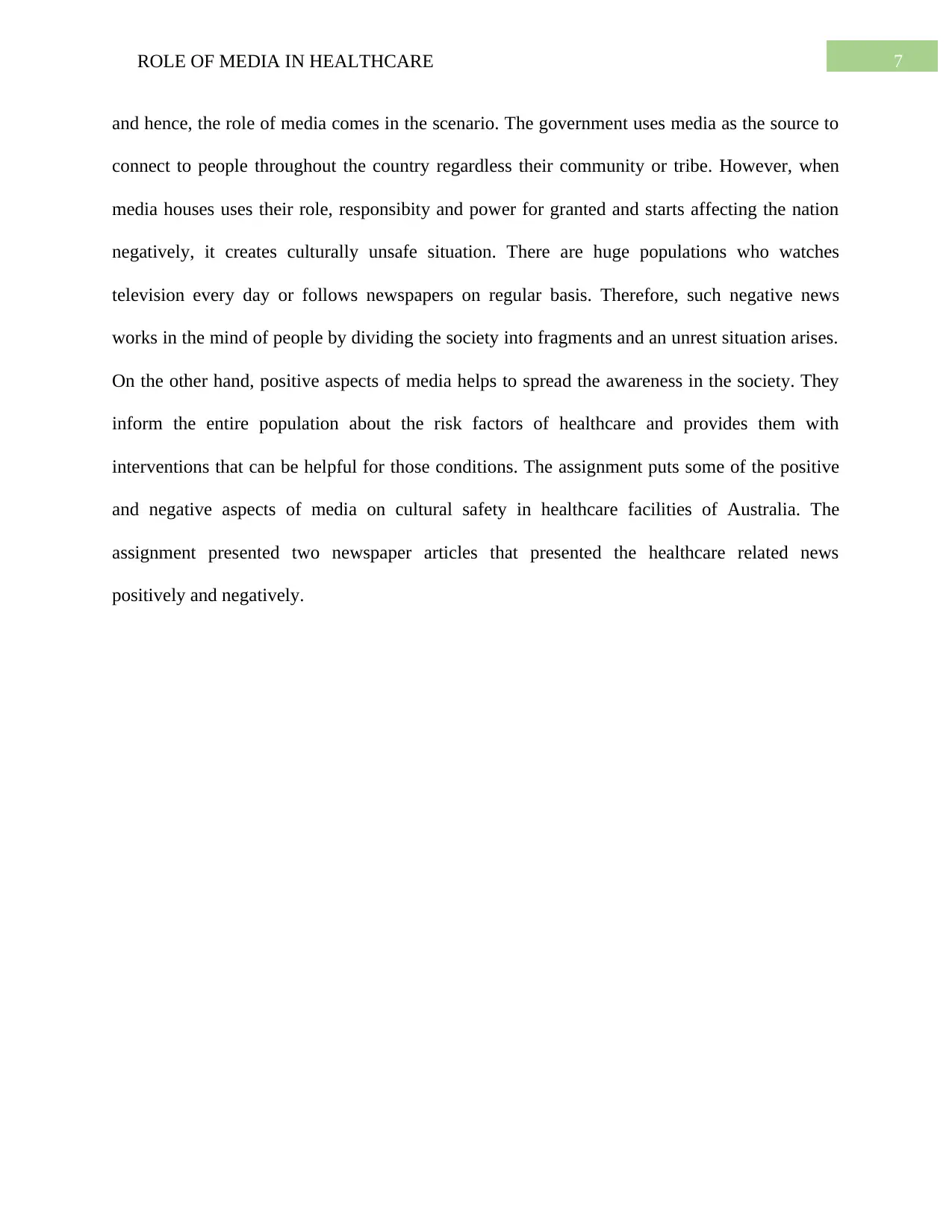
7ROLE OF MEDIA IN HEALTHCARE
and hence, the role of media comes in the scenario. The government uses media as the source to
connect to people throughout the country regardless their community or tribe. However, when
media houses uses their role, responsibity and power for granted and starts affecting the nation
negatively, it creates culturally unsafe situation. There are huge populations who watches
television every day or follows newspapers on regular basis. Therefore, such negative news
works in the mind of people by dividing the society into fragments and an unrest situation arises.
On the other hand, positive aspects of media helps to spread the awareness in the society. They
inform the entire population about the risk factors of healthcare and provides them with
interventions that can be helpful for those conditions. The assignment puts some of the positive
and negative aspects of media on cultural safety in healthcare facilities of Australia. The
assignment presented two newspaper articles that presented the healthcare related news
positively and negatively.
and hence, the role of media comes in the scenario. The government uses media as the source to
connect to people throughout the country regardless their community or tribe. However, when
media houses uses their role, responsibity and power for granted and starts affecting the nation
negatively, it creates culturally unsafe situation. There are huge populations who watches
television every day or follows newspapers on regular basis. Therefore, such negative news
works in the mind of people by dividing the society into fragments and an unrest situation arises.
On the other hand, positive aspects of media helps to spread the awareness in the society. They
inform the entire population about the risk factors of healthcare and provides them with
interventions that can be helpful for those conditions. The assignment puts some of the positive
and negative aspects of media on cultural safety in healthcare facilities of Australia. The
assignment presented two newspaper articles that presented the healthcare related news
positively and negatively.
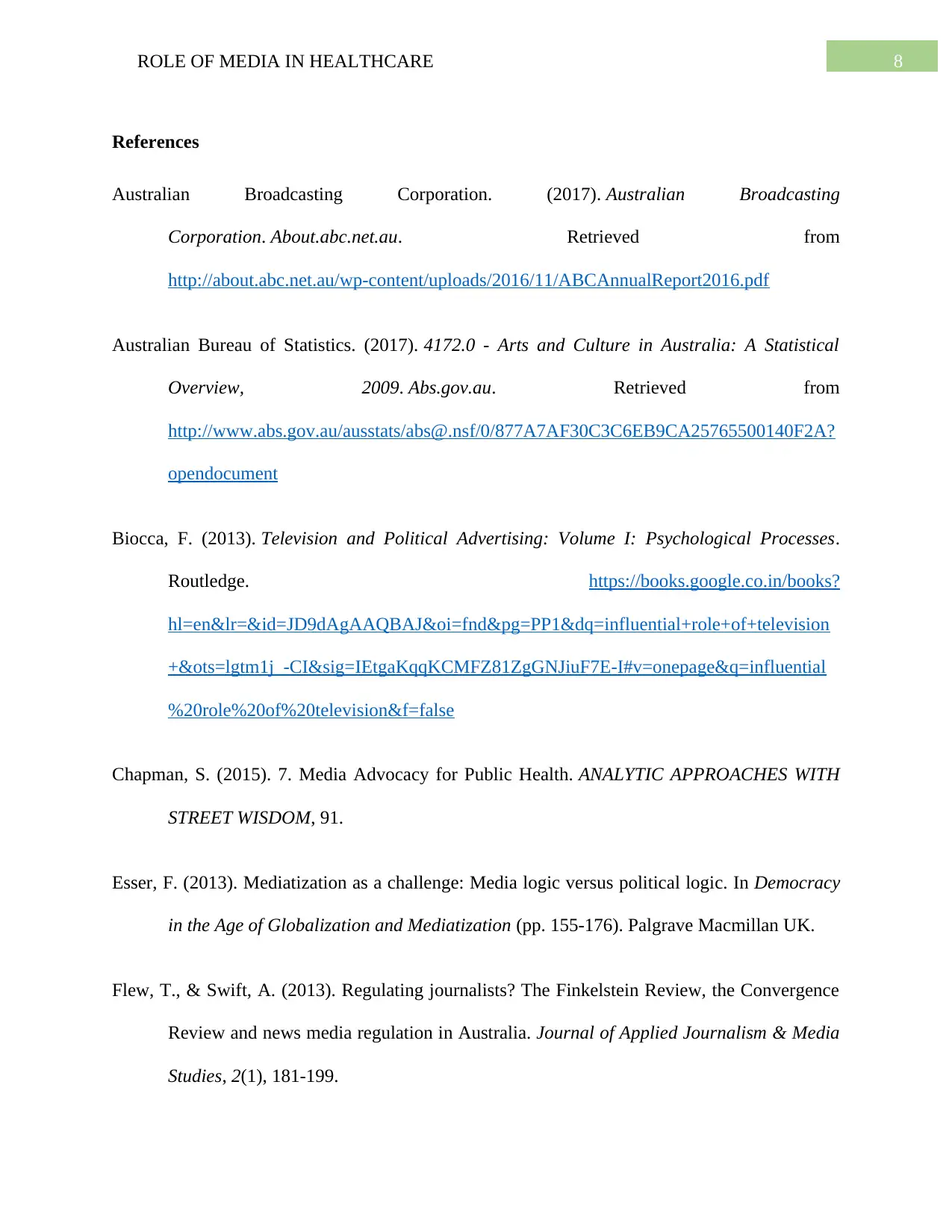
8ROLE OF MEDIA IN HEALTHCARE
References
Australian Broadcasting Corporation. (2017). Australian Broadcasting
Corporation. About.abc.net.au. Retrieved from
http://about.abc.net.au/wp-content/uploads/2016/11/ABCAnnualReport2016.pdf
Australian Bureau of Statistics. (2017). 4172.0 - Arts and Culture in Australia: A Statistical
Overview, 2009. Abs.gov.au. Retrieved from
http://www.abs.gov.au/ausstats/abs@.nsf/0/877A7AF30C3C6EB9CA25765500140F2A?
opendocument
Biocca, F. (2013). Television and Political Advertising: Volume I: Psychological Processes.
Routledge. https://books.google.co.in/books?
hl=en&lr=&id=JD9dAgAAQBAJ&oi=fnd&pg=PP1&dq=influential+role+of+television
+&ots=lgtm1j_-CI&sig=IEtgaKqqKCMFZ81ZgGNJiuF7E-I#v=onepage&q=influential
%20role%20of%20television&f=false
Chapman, S. (2015). 7. Media Advocacy for Public Health. ANALYTIC APPROACHES WITH
STREET WISDOM, 91.
Esser, F. (2013). Mediatization as a challenge: Media logic versus political logic. In Democracy
in the Age of Globalization and Mediatization (pp. 155-176). Palgrave Macmillan UK.
Flew, T., & Swift, A. (2013). Regulating journalists? The Finkelstein Review, the Convergence
Review and news media regulation in Australia. Journal of Applied Journalism & Media
Studies, 2(1), 181-199.
References
Australian Broadcasting Corporation. (2017). Australian Broadcasting
Corporation. About.abc.net.au. Retrieved from
http://about.abc.net.au/wp-content/uploads/2016/11/ABCAnnualReport2016.pdf
Australian Bureau of Statistics. (2017). 4172.0 - Arts and Culture in Australia: A Statistical
Overview, 2009. Abs.gov.au. Retrieved from
http://www.abs.gov.au/ausstats/abs@.nsf/0/877A7AF30C3C6EB9CA25765500140F2A?
opendocument
Biocca, F. (2013). Television and Political Advertising: Volume I: Psychological Processes.
Routledge. https://books.google.co.in/books?
hl=en&lr=&id=JD9dAgAAQBAJ&oi=fnd&pg=PP1&dq=influential+role+of+television
+&ots=lgtm1j_-CI&sig=IEtgaKqqKCMFZ81ZgGNJiuF7E-I#v=onepage&q=influential
%20role%20of%20television&f=false
Chapman, S. (2015). 7. Media Advocacy for Public Health. ANALYTIC APPROACHES WITH
STREET WISDOM, 91.
Esser, F. (2013). Mediatization as a challenge: Media logic versus political logic. In Democracy
in the Age of Globalization and Mediatization (pp. 155-176). Palgrave Macmillan UK.
Flew, T., & Swift, A. (2013). Regulating journalists? The Finkelstein Review, the Convergence
Review and news media regulation in Australia. Journal of Applied Journalism & Media
Studies, 2(1), 181-199.
⊘ This is a preview!⊘
Do you want full access?
Subscribe today to unlock all pages.

Trusted by 1+ million students worldwide
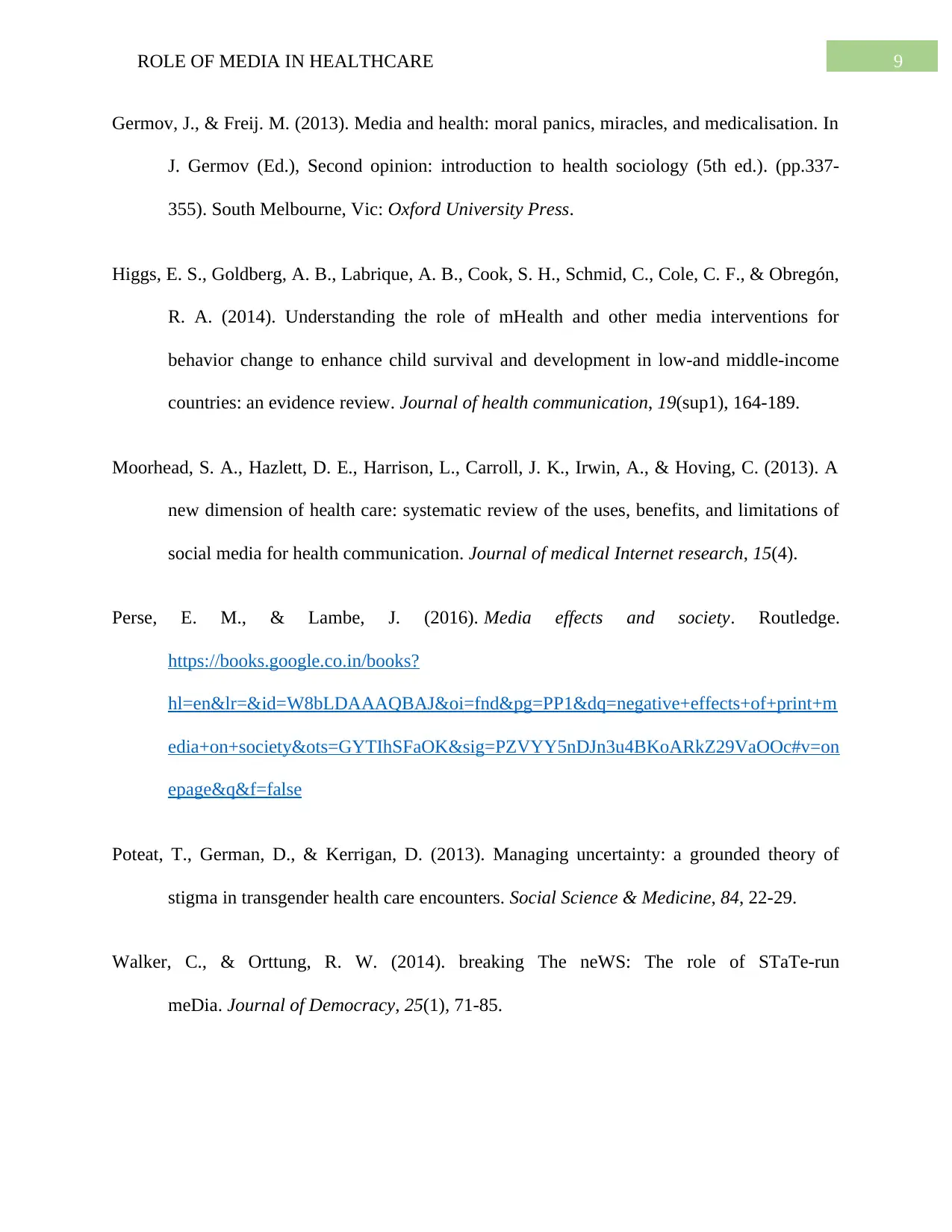
9ROLE OF MEDIA IN HEALTHCARE
Germov, J., & Freij. M. (2013). Media and health: moral panics, miracles, and medicalisation. In
J. Germov (Ed.), Second opinion: introduction to health sociology (5th ed.). (pp.337-
355). South Melbourne, Vic: Oxford University Press.
Higgs, E. S., Goldberg, A. B., Labrique, A. B., Cook, S. H., Schmid, C., Cole, C. F., & Obregón,
R. A. (2014). Understanding the role of mHealth and other media interventions for
behavior change to enhance child survival and development in low-and middle-income
countries: an evidence review. Journal of health communication, 19(sup1), 164-189.
Moorhead, S. A., Hazlett, D. E., Harrison, L., Carroll, J. K., Irwin, A., & Hoving, C. (2013). A
new dimension of health care: systematic review of the uses, benefits, and limitations of
social media for health communication. Journal of medical Internet research, 15(4).
Perse, E. M., & Lambe, J. (2016). Media effects and society. Routledge.
https://books.google.co.in/books?
hl=en&lr=&id=W8bLDAAAQBAJ&oi=fnd&pg=PP1&dq=negative+effects+of+print+m
edia+on+society&ots=GYTIhSFaOK&sig=PZVYY5nDJn3u4BKoARkZ29VaOOc#v=on
epage&q&f=false
Poteat, T., German, D., & Kerrigan, D. (2013). Managing uncertainty: a grounded theory of
stigma in transgender health care encounters. Social Science & Medicine, 84, 22-29.
Walker, C., & Orttung, R. W. (2014). breaking The neWS: The role of STaTe-run
meDia. Journal of Democracy, 25(1), 71-85.
Germov, J., & Freij. M. (2013). Media and health: moral panics, miracles, and medicalisation. In
J. Germov (Ed.), Second opinion: introduction to health sociology (5th ed.). (pp.337-
355). South Melbourne, Vic: Oxford University Press.
Higgs, E. S., Goldberg, A. B., Labrique, A. B., Cook, S. H., Schmid, C., Cole, C. F., & Obregón,
R. A. (2014). Understanding the role of mHealth and other media interventions for
behavior change to enhance child survival and development in low-and middle-income
countries: an evidence review. Journal of health communication, 19(sup1), 164-189.
Moorhead, S. A., Hazlett, D. E., Harrison, L., Carroll, J. K., Irwin, A., & Hoving, C. (2013). A
new dimension of health care: systematic review of the uses, benefits, and limitations of
social media for health communication. Journal of medical Internet research, 15(4).
Perse, E. M., & Lambe, J. (2016). Media effects and society. Routledge.
https://books.google.co.in/books?
hl=en&lr=&id=W8bLDAAAQBAJ&oi=fnd&pg=PP1&dq=negative+effects+of+print+m
edia+on+society&ots=GYTIhSFaOK&sig=PZVYY5nDJn3u4BKoARkZ29VaOOc#v=on
epage&q&f=false
Poteat, T., German, D., & Kerrigan, D. (2013). Managing uncertainty: a grounded theory of
stigma in transgender health care encounters. Social Science & Medicine, 84, 22-29.
Walker, C., & Orttung, R. W. (2014). breaking The neWS: The role of STaTe-run
meDia. Journal of Democracy, 25(1), 71-85.
Paraphrase This Document
Need a fresh take? Get an instant paraphrase of this document with our AI Paraphraser
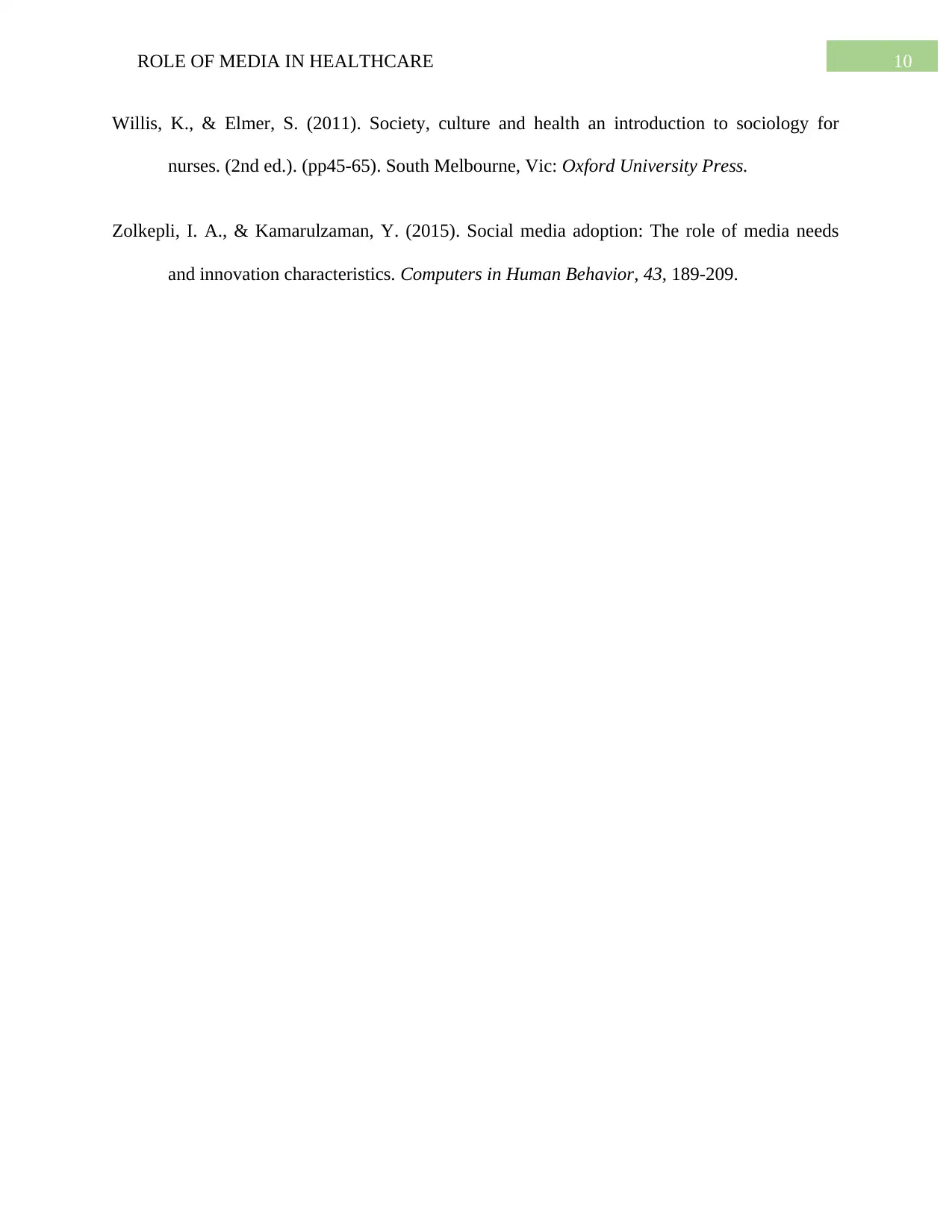
10ROLE OF MEDIA IN HEALTHCARE
Willis, K., & Elmer, S. (2011). Society, culture and health an introduction to sociology for
nurses. (2nd ed.). (pp45-65). South Melbourne, Vic: Oxford University Press.
Zolkepli, I. A., & Kamarulzaman, Y. (2015). Social media adoption: The role of media needs
and innovation characteristics. Computers in Human Behavior, 43, 189-209.
Willis, K., & Elmer, S. (2011). Society, culture and health an introduction to sociology for
nurses. (2nd ed.). (pp45-65). South Melbourne, Vic: Oxford University Press.
Zolkepli, I. A., & Kamarulzaman, Y. (2015). Social media adoption: The role of media needs
and innovation characteristics. Computers in Human Behavior, 43, 189-209.
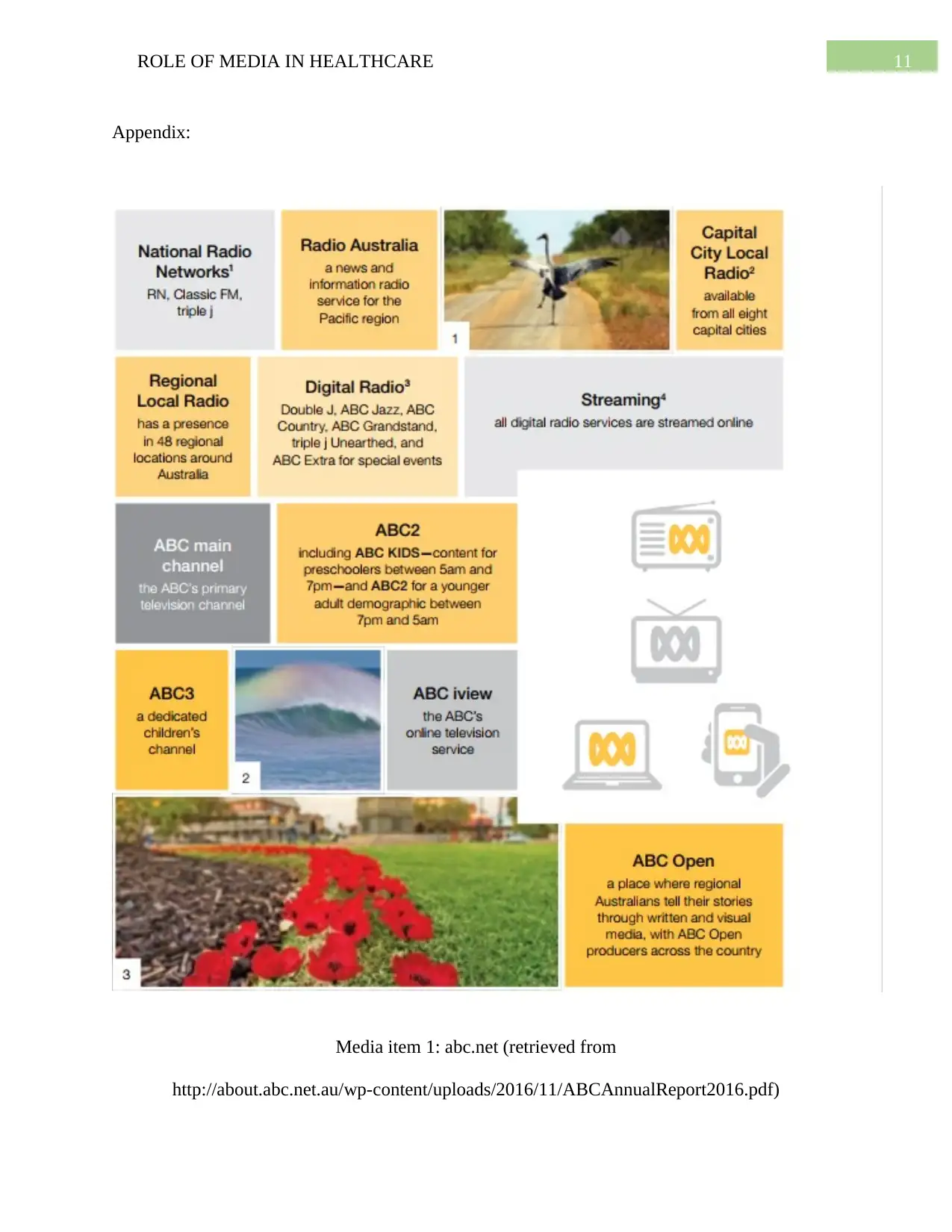
11ROLE OF MEDIA IN HEALTHCARE
Appendix:
Media item 1: abc.net (retrieved from
http://about.abc.net.au/wp-content/uploads/2016/11/ABCAnnualReport2016.pdf)
Appendix:
Media item 1: abc.net (retrieved from
http://about.abc.net.au/wp-content/uploads/2016/11/ABCAnnualReport2016.pdf)
⊘ This is a preview!⊘
Do you want full access?
Subscribe today to unlock all pages.

Trusted by 1+ million students worldwide
1 out of 13
Related Documents
Your All-in-One AI-Powered Toolkit for Academic Success.
+13062052269
info@desklib.com
Available 24*7 on WhatsApp / Email
![[object Object]](/_next/static/media/star-bottom.7253800d.svg)
Unlock your academic potential
Copyright © 2020–2025 A2Z Services. All Rights Reserved. Developed and managed by ZUCOL.





